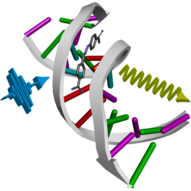
Helium Nanodroplets
The Helium Droplet Laboratory
Prof. Dr. Alkwin Slenczka
In the field of physical chemistry and molecular physics superfluid helium-nanodroplets are well established as a host system for preparing cold samples such as single atoms or molecules or homogeneous or heterogeneous clusters. At a temperature of only 0.38 (1) K, the isotope 4He is in the superfluid phase and behaves like a quantum liquid. The key properties are high thermal conductivity and vanishing viscosity. Compared to alternative host systems, the perturbative influence of superfluid-helium on a guest system is negligible. At sufficient energy resolution, however, negligible perturbation is far from absence of perturbation.
After some experience in the field of photophysics or photochemistry, our laboratory is dedicated to the study of guest-host interactions observed on molecules or molecular clusters in superfluid helium nanodroplets. The experimental approach is electronic spectroscopy by means of a single-mode auto-scan ring-dye-laser with a band width of less than 1 MHz. Upon electronic excitation, the fluorescence response is recorded as a function of the excitation frequency (fluorescence excitation spectrum) or dispersed by means of a grating spectrograph, the excitation frequency remaining fixed at a molecular resonance.
Currently, the focus of our experimental activities is the identification of the rotational band structure within the line shape of electronic transitions of molecules in helium droplets. According to our earlier work, the line shape is dominated by an inhomogeneous line broadening caused by the experimental droplet size distribution. By studying the line shape of electronic transitions and their changes, as observed in Stark spectra, the contribution of the rotating band system is to be identified. In parallel, corresponding spectra are recorded from the gas phase, which serve to cross-check the analysis of the rotational band system and, above all, to assess the influence of the helium environment on the doping system.
Our experimental activities will provide key information on microsolvation of molecules in superfluid helium. We head to further clarify the presence of a helium solvation layer and its dynamics upon electronic excitation. In addition, isomeric configurations of molecular clusters and their dynamics upon electronic excitation both under the influence of a superfluid helium environment are subject of our current research.

